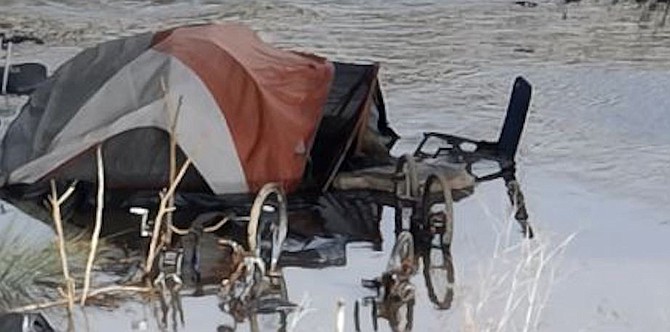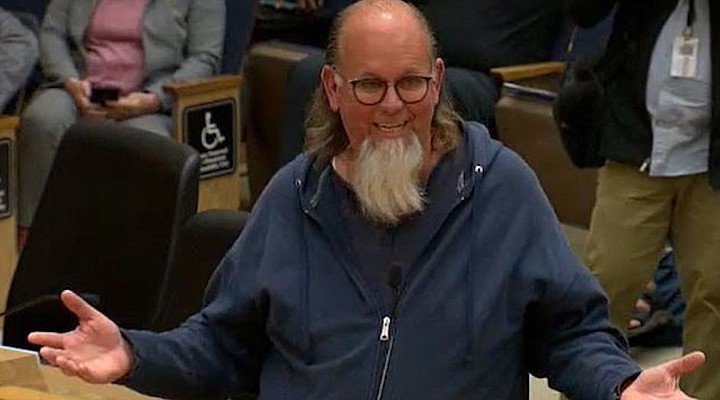 Facebook
Facebook
 X
X
 Instagram
Instagram
 TikTok
TikTok
 Youtube
Youtube

In January, floodwaters swept away the tents, blankets and clothing of the homeless living along the San Diego River bed from Ocean Beach to Lakeside. Now some say the city is trying to sweep the unsheltered off every spot on the map.
An ordinance proposed by Councilman Stephen Whitburn and backed by Mayor Todd Gloria would ban homeless camps not only in riverbeds and canyons, but on all public property.
"Every neighborhood, from Barrio Logan to Mira Mesa, from La Jolla to downtown," Whitburn told the Land Use and Housing Committee last week, introducing his proposal.
"Regardless of shelter availability, the prohibition on encampments will always apply within two blocks of a school or a shelter; along trolley tracks, any waterway or open space, and in parks - with the goal of protecting health and safety.
The other aim of the ordinance is getting people to accept the shelter and services the city provides, he said. One new option officials are looking into is a safe sleeping site with connection to housing and other services.

The measure was welcomed by those who live in Whitburn's downtown district, who said their neighborhoods are unsafe because of the growing homeless population, and by teachers whose students had witnessed violence and drug use next to their schools.
In a 3-1 vote, the committee agreed to forward the proposed ordinance to the full city council, making no recommendation and calling for a comprehensive plan that expands shelter options, outreach, and enforcement.
According to a staff report, the city has increased shelter bed capacity by 68 percent in the last two years. As of February 2023, the city had more than 1,780 shelter beds. But that's up against a rising tide.
Statistics from the Downtown San Diego Partnership show that during the last six months of 2022, for every 10 people who were able to find housing through city-funded homeless services, 13 San Diegans fell out of housing.
"This proposed ordinance does nothing to address the shortage of housing," said Shelby Thomas, with the San Diego Housing Federation, asking the city to instead focus on protecting tenants and affordable housing and increasing access to social services.
Since over 1,700 homeless live downtown, along with the hundreds in the parks and other locations included in the ordinance - where will they go when forced to move on?
"Normally when you do something, especially something big like this, you have some kind of proof and evidence it's going to work," said homeless advocate Michael McConnell, who set up a fundraiser in January to help the people who lost everything to the riverbed flooding.
"Not only have experts told you from all over the country that this doesn't work, it actually makes things worse." McConnell said he has spent years documenting San Diego's sweeps against the homeless, and the current proposal is nothing new. It will simply squeeze people into other neighborhoods.
"I've seen sweeps in the Midway area drive people into the riverbed. The riverbed population goes up."
Others questioned the enforceability of the ordinance, including councilman Kent Lee, who voted against advancing it to the full council due to the routine shortage of shelter beds.
Homeless advocate John Brady said another 900 beds will be going offline in the next nine months, as Golden Hall closes and the Newton shelter is relocated.
"You cannot make it illegal for this many people to not be able to live in the city of San Diego in this many areas."


In January, floodwaters swept away the tents, blankets and clothing of the homeless living along the San Diego River bed from Ocean Beach to Lakeside. Now some say the city is trying to sweep the unsheltered off every spot on the map.
An ordinance proposed by Councilman Stephen Whitburn and backed by Mayor Todd Gloria would ban homeless camps not only in riverbeds and canyons, but on all public property.
"Every neighborhood, from Barrio Logan to Mira Mesa, from La Jolla to downtown," Whitburn told the Land Use and Housing Committee last week, introducing his proposal.
"Regardless of shelter availability, the prohibition on encampments will always apply within two blocks of a school or a shelter; along trolley tracks, any waterway or open space, and in parks - with the goal of protecting health and safety.
The other aim of the ordinance is getting people to accept the shelter and services the city provides, he said. One new option officials are looking into is a safe sleeping site with connection to housing and other services.

The measure was welcomed by those who live in Whitburn's downtown district, who said their neighborhoods are unsafe because of the growing homeless population, and by teachers whose students had witnessed violence and drug use next to their schools.
In a 3-1 vote, the committee agreed to forward the proposed ordinance to the full city council, making no recommendation and calling for a comprehensive plan that expands shelter options, outreach, and enforcement.
According to a staff report, the city has increased shelter bed capacity by 68 percent in the last two years. As of February 2023, the city had more than 1,780 shelter beds. But that's up against a rising tide.
Statistics from the Downtown San Diego Partnership show that during the last six months of 2022, for every 10 people who were able to find housing through city-funded homeless services, 13 San Diegans fell out of housing.
"This proposed ordinance does nothing to address the shortage of housing," said Shelby Thomas, with the San Diego Housing Federation, asking the city to instead focus on protecting tenants and affordable housing and increasing access to social services.
Since over 1,700 homeless live downtown, along with the hundreds in the parks and other locations included in the ordinance - where will they go when forced to move on?
"Normally when you do something, especially something big like this, you have some kind of proof and evidence it's going to work," said homeless advocate Michael McConnell, who set up a fundraiser in January to help the people who lost everything to the riverbed flooding.
"Not only have experts told you from all over the country that this doesn't work, it actually makes things worse." McConnell said he has spent years documenting San Diego's sweeps against the homeless, and the current proposal is nothing new. It will simply squeeze people into other neighborhoods.
"I've seen sweeps in the Midway area drive people into the riverbed. The riverbed population goes up."
Others questioned the enforceability of the ordinance, including councilman Kent Lee, who voted against advancing it to the full council due to the routine shortage of shelter beds.
Homeless advocate John Brady said another 900 beds will be going offline in the next nine months, as Golden Hall closes and the Newton shelter is relocated.
"You cannot make it illegal for this many people to not be able to live in the city of San Diego in this many areas."
Comments